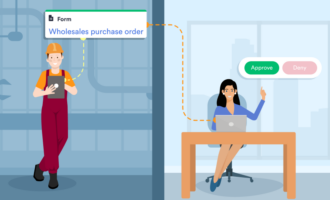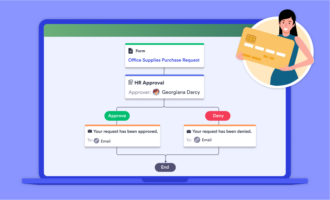How to fill out a purchase order
- Put together a purchase requisition
- Collaborate with your team
- Place your order
- Double-check your work
- Automate with Jotform
In business, the purchase order process works a bit like a food delivery app: Specify what you want, place menu items in the cart, and place the order — all within a convenient digital interface.
Though that comparison may sound simplistic, learning how to fill out a purchase order accurately is the best way to ensure you get the supplies you need to operate efficiently. That way, when it comes time for delivery, you won’t lose time tracking down orders or waiting for supplies; you’ll be able to get to work as soon as your order is delivered.
Here’s what you need to know about how to fill out a purchase order.
Do your homework
Before you can complete a purchase order, you’ll first need to put together a purchase requisition, an internal document that collects the information for a purchase order agreement with a supplier.
Your purchase requisition should include a description of the goods you’re requesting, as well as exact amounts. Be sure to eliminate any uncertainty about these details to make the process run smoothly.
Collaborate with your team
Once you’ve developed a purchase requisition, check with your team to make sure you’re requesting the right items and the correct amounts.
The person who sends a purchase order to a supplier won’t necessarily be the person who works most closely with the goods you’re ordering, and that person may have additional knowledge to share. This is why having an approval process that goes through a clear communication channel is so important.
Work with your team to determine the amount of goods you need, why, and what they’ll cost. In the same way one of your team members needs to ask for supplies, their manager needs to understand why they’re asking for them. Then, when it’s time to approach a business partner for an order, you’ll be clear about what you want and why you want it, reducing the time spent answering follow-up questions.
Place your order
Once you’ve created a purchase requisition and decided what you’ll be asking for, make sure that the terms of the purchase, like delivery date and payment method, are agreeable to both parties. This step is critical because once a purchase order is signed, it becomes a legally binding document.
Typically, these details include the cost of the items you’re ordering, how you’ll pay for them, an official purchase order number, and information about both businesses, like contact numbers and billing addresses. Establishing this contract creates a record you can refer back to in case questions arise or you want to check on incoming inventory.
For example, if you find in the middle of a project that you need more materials to finish your work, a purchase order can ensure you get the necessary supplies promptly. It’s also a way to operate more efficiently — by maintaining detailed records, you can continually take stock of what you have and adjust future orders accordingly. Plus, the more you carry out this process, the more you’ll refine it.
Double-check your work
Once you’ve filed and agreed to a purchase order, a supplier will typically send a sales order, which serves as a receipt, confirming the goods you’ve ordered. This process eliminates the possibility of any errors in procurement.
Looking over the sales order produced from your purchase order is a way to retrace your steps. From this point, all that’s left is to double-check your items when they arrive and deliver the payment amount you agreed to in the purchase order.
Automate with Jotform
Manually filling in information for each purchase order takes a lot of time. A platform like Jotform can assist with automating your purchase order workflow.
Jotform allows you to create a purchase order and assign tasks to members of your team within these forms. You can even complete the process on the go with Jotform Mobile Forms, which allows you to address comments with the touch of a button.
With Jotform Approvals, you can create individual approval workflows to track the status of your orders and where you are in the process. Think of Jotform as your go-to database for tracking form submissions and information. You can host forms, track your tasks, get your orders out on time, and monitor their status every step of the way.
Procuring supplies
Whether it’s raw materials, supplies, or machines, your business will always need certain items to operate. Establishing proper procurement strategies — and learning how to fill out a purchase order — ensures you’re one step ahead. Couple that with an all-in-one platform like Jotform to store, record, and send purchase orders, and you have an unstoppable combination.

















Send Comment: